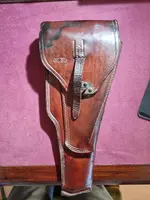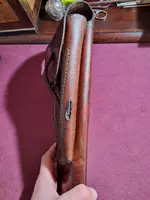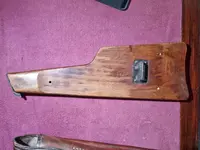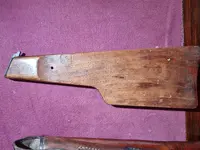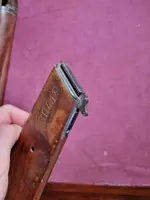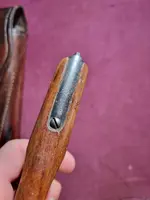Nice scarce item.
Yes, your combo-holster was made to take the FN Herstal semi-automatic 9mm. Although referred to as a “Browning” (and Browning Arms did indeed make some of them), John Browning’s original design was adapted by Dieudonné Saive of Fabrique Nationale (FN) at Herstal in Belgium through the late 1920s/early 1930s. The pistol was first adopted by Belgium for military service in 1935, designated as the “Browning P-35” and produced by Fabrique Nationale in Belgium.
There were two models: an “Ordinary Model” with fixed sights; and an “Adjustable Rear Sight Model”. Only the latter had a slotted grip for attaching a wooden shoulder stock, so your holster was specifically made for that model, which was discontinued in the early years of WWII.
Part of the reason for the discontinuation was that the Fabrique Nationale factory was taken over by the Wehrmacht after the Nazis occupied Belgium on 28th May 1940. The factory was then used by the Germans to produce equivalent pistols under the new designation “9mm Pistole 640(b)”. There were three models produced under occupation, the first of which retained the slotted grip for a shoulder stock but this was abandoned with the introduction of the second model in January 1941. Mostly these pistols are believed to have been issued to the Waffen-SS and Fallschirmjäger personnel (the parachute branch of the Luftwaffe).
In the meantime FN Herstal set up a new operation in Canada using John Inglis and Company’s factory to produce for the allies. The name “Hi-Power” (a reference to the 13-round magazine capacity) was adopted at that time and continued to be used when production returned to Belgium after the war.
The AC.39 embossed stamp on your holster is a Belgian military inspection mark, but it’s a pre-war mark, or at least a pre-occupation mark. So your holster was made sometime between 1935-1940, but could well be a ‘surrendered’ or ‘captured’ item from the earliest years of the war. My understanding is that once the Germans took over, the holsters were soon produced with German markings and without the stock compartment from 1941 onwards. They wouldn’t have wasted any Belgian ‘war surplus’ and certainly re-issued many captured items to their own forces but mostly the Belgian-marked holsters that were re-used by the Germans seem to have had the shoulder stock compartment removed for use with the second or third models of the 640(b) that had no provision for a stock.
Value-wise I don’t know, but I could see a collector paying a Euro price in the mid to high hundreds for it, especially since you have the stock as well.

